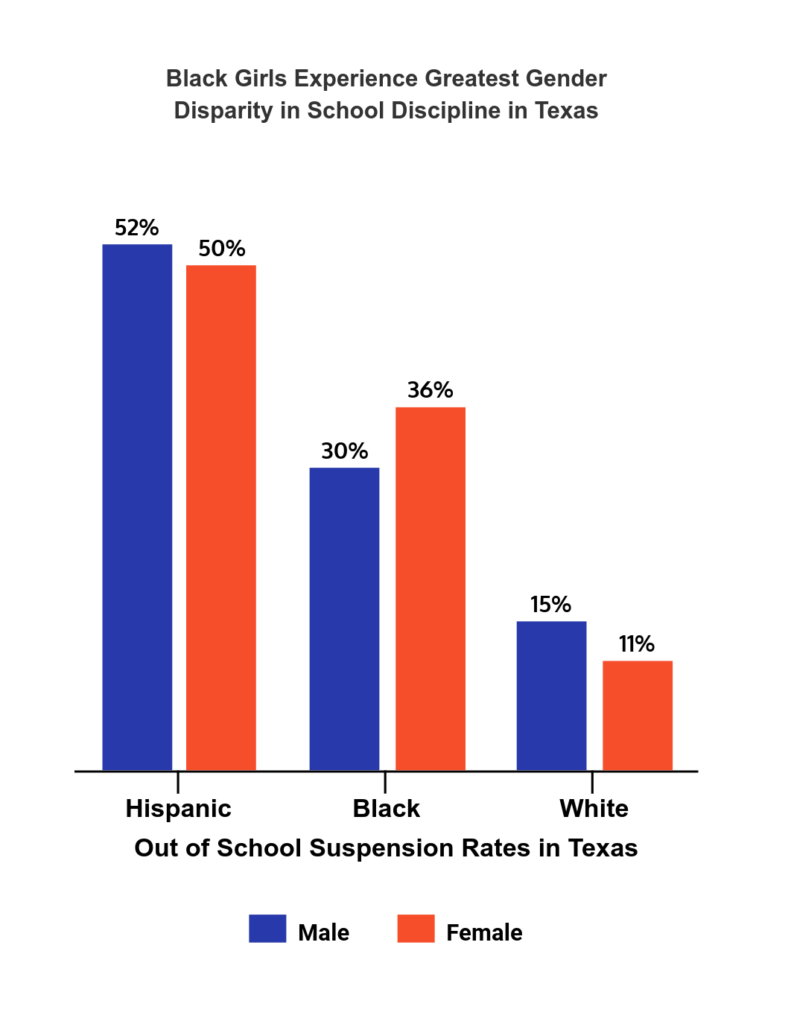• Chloe Latham Sikes, M.A. • IDRA Newsletter • February 2020 •


Disparate Impacts of Dress Codes by Race and Gender
No child should have their body objectified or shamed for what they wear to school or how they stylistically express themselves. Yet, the design and associated consequences of dress code policies can have disparate effects as a result of gender and racial biases.
The consequences of dress code violations contribute to the school-to-prison pipeline that systematically targets students of color. Suspending students or sending them out from the classroom to change clothes – for any reason – can compromise students’ learning and instruction (NWLC, 2018).
Black girls experience the greatest racial and gender disproportionally in being suspended or expelled from school than any other group, due in part to disciplinary dress codes (Crenshaw, 2015). One report focused on Washington, D.C., found that schools suspend Black girls at nearly 21 times the rate of White girls (NWLC, 2018).
In Texas, for example, Black girls experience the greatest gender disparity in discipline across racial groups. They are suspended at higher rates than their Black male counterparts through both out-of-school (36% compared to 30%) and in-school suspensions (25% vs. 21%) (OCR, 2018).


Initiatives to Address Harmful Dress Codes and Discipline
However, students have begun to push back against draconian dress code policies (Nittle, 2018; Malik, 2020) and promote fair dress codes that focus on students’ safety and civil rights. Fair dress codes uphold respect for cultural expression, prohibit hate speech in accordance with the law, and have no disparate impact based on race or gender nor harmful exclusionary disciplinary responses.
Politicians and advocacy groups have noticed this trend. Federal lawmakers recently introduced legislation that addresses racial and gender disparities in school discipline and dress code enforcement (Speri, 2019).
Several school districts, including Austin ISD, modified their school dress code policies to prioritize the health and safety of students, rather than objectify girls’ bodies or discriminate against culturally-significant forms of dress and style. The momentum is growing as legislators in 21 state are pushing for legislation that bans hair discrimination.
Recommendations
IDRA recommends the following approaches to create and track more fair, safe and respectful dress code policies.
- State policymakers should restrict schools from issuing exclusionary discipline consequences for dress code violations.
- State education agencies should disaggregate discipline rate reports for dress code violations by race/ethnicity and gender.
- Students, families and community members can advocate that their local school districts modify their dress code policies to be fair, safe, and respectful of self-expression without exclusionary disciplinary consequences.
- School districts should modify dress code policies to protect students’ civil rights and personal safety without exclusionary disciplinary consequences.
At little or no cost, the IDRA EAC-South can work with school districts in the U.S. South to review their dress codes and their local student codes of conduct to ensure they are equitable and affirming. (See www.idra.org/eac-south for more information.)
Resources
Crenshaw, K.W. (2015). Black Girls Matter: Pushed Out, Overpoliced and Underprotected. New York, NY: African American Policy Forum; Center for Intersectionality and Social Policy Studies.
Malik, A. (February 11, 2020). “SAISD students ask for limits on school policing, amendments to their Bill of Rights,” San Antonio Express-News.
Office for Civil Rights. (2018). 2013-14 State and National Estimations. Washington, D.C.: U.S. Department of Education.
National Women’s Law Center. (2018). Dress Coded: Black Girls, Bodies, and Bias in D.C. Schools. Washington, D.C.: NWLC.
Nittle, N. (2018, Sept. 13). “Students are Waging War on Sexist and Racist School Dress Codes – And They’re Winning,” Vox.
Sherwin, G. (2017). 5 Things Public Schools Can and Can’t Do When It Comes to Dress Codes. New York, N.Y.: ACLU.
Speri, A. (2019, December 5). “New Legislation Aims to End the ‘School to Confinement’ Pathway,” The Intercept.
Chloe Latham Sikes, M.A., is IDRA’s deputy director of policy. Comments and questions may be directed to her via e-mail at chloe.sikes@idra.org.
![]()
![]()


